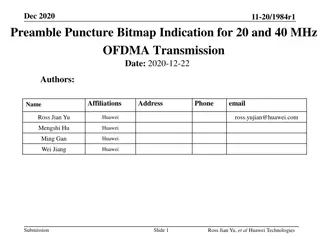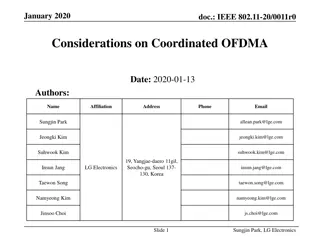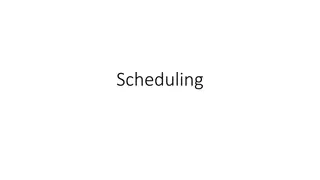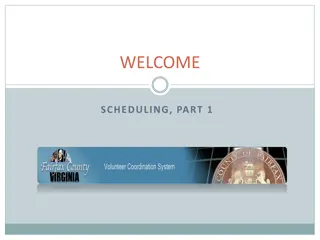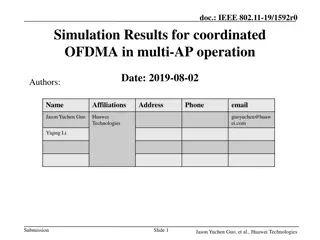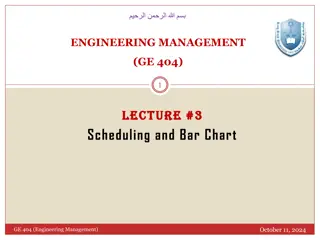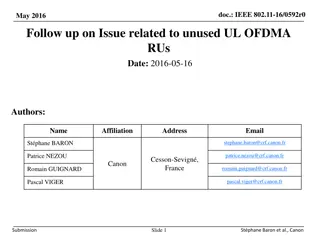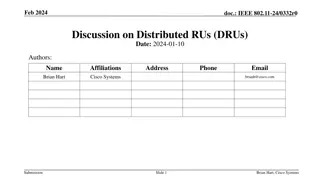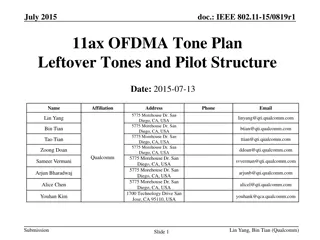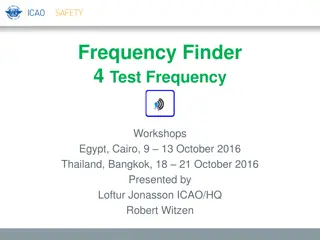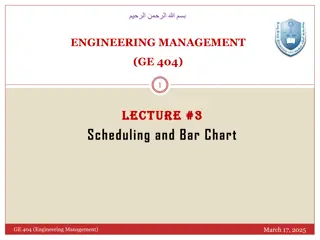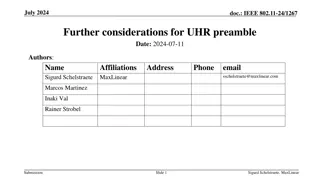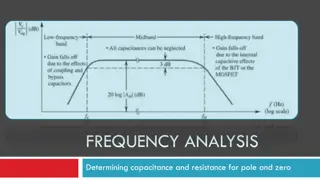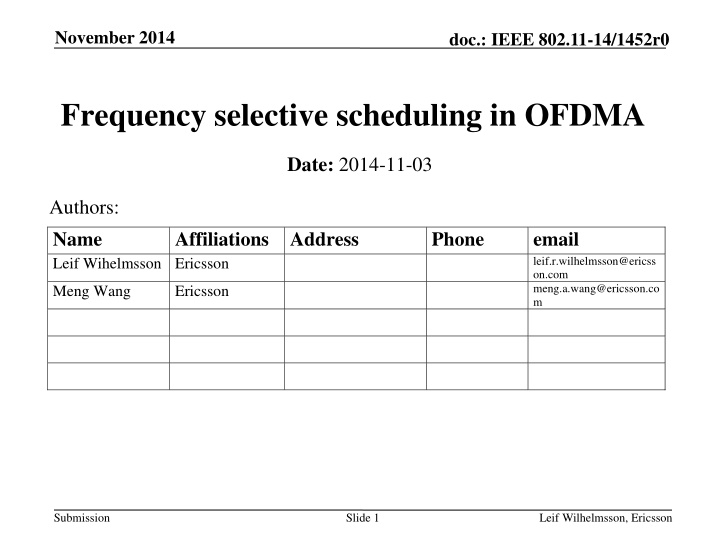
Frequency Selective Scheduling in OFDMA for IEEE 802.11-14
Explore the benefits of frequency selective scheduling in OFDMA for IEEE 802.11-14 networks without extensive sounding. Initial simulation results highlight the potential gains and impact of channel estimation errors, alongside ways to obtain accurate channel knowledge. Motivated by improving spectrum efficiency, this study addresses the evaluation methodology and assumptions for the implementation of OFDMA technology.
Download Presentation

Please find below an Image/Link to download the presentation.
The content on the website is provided AS IS for your information and personal use only. It may not be sold, licensed, or shared on other websites without obtaining consent from the author. If you encounter any issues during the download, it is possible that the publisher has removed the file from their server.
You are allowed to download the files provided on this website for personal or commercial use, subject to the condition that they are used lawfully. All files are the property of their respective owners.
The content on the website is provided AS IS for your information and personal use only. It may not be sold, licensed, or shared on other websites without obtaining consent from the author.
E N D
Presentation Transcript
November 2014 doc.: IEEE 802.11-14/1452r0 Frequency selective scheduling in OFDMA Date: 2014-11-03 Authors: Name Leif Wihelmsson Ericsson Affiliations Address Phone email leif.r.wilhelmsson@ericss on.com meng.a.wang@ericsson.co m Meng Wang Ericsson Submission Slide 1 Leif Wilhelmsson, Ericsson
November 2014 doc.: IEEE 802.11-14/1452r0 Abstract OFDMA allows for frequency selective scheduling To achieve the scheduling gain requires accurate channel knowledge at the AP without extensive sounding This contribution presents initial simulation results for a simple set-up concerning possible gain achieved by frequency selective scheduling as well as impact of channel estimation error Possible ways to obtain channel knowledge at the AP are also discussed Submission Slide 2 Leif Wilhelmsson, Ericsson
November 2014 doc.: IEEE 802.11-14/1452r0 Outline Motivation/Related work Assumptions and problem description Evaluation methodology Potential gain using frequency selective scheduling Possible ways to obtain channel knowledge Conclusions Submission Slide 3 Leif Wilhelmsson, Ericsson
November 2014 doc.: IEEE 802.11-14/1452r0 Motivation/Related work OFDMA is one of technologies discussed for improving spectrum efficiency in IEEE 802.11ax It may be expected to have its largest benefit for small packets, where substantial gain has been seen [1] Also for larger packets simple OFDMA has been argued to achieve gain [2] It was demonstrated in [3] that frequency selective scheduling can rather substantially improve the throughput Submission Slide 4 Leif Wilhelmsson, Ericsson
November 2014 doc.: IEEE 802.11-14/1452r0 Assumptions and problem description Frequency STA2 STA23 STA43 STA13 STA33 Single BSS, SISO, 20 MHz channel, 4 users Perfectly orthogonal users Each user is assigned continuous subcarriers in DL, here denoted a subband, for example as illustrated above Submission Slide 5 Leif Wilhelmsson, Ericsson
November 2014 doc.: IEEE 802.11-14/1452r0 Evaluation methodology Use methodology similar to [2], i.e., Map the sub-carrier SNR to data rate using capacity formula Gain expressed in SNR or throughput increase in percentage Performance comparison Baseline: one user always transmits on the same 5MHz subband Random scheduling: one user transmits on a random subband Frequency selective scheduling: users are allocated to suitable 5MHz subband to transmit on (A simple scheduling algorithm: allocate the sub-band with the highest average frequency response to the corresponding user; proceed to apply algorithm to the rest of sub-bands and users) Submission Slide 6 Leif Wilhelmsson, Ericsson
November 2014 doc.: IEEE 802.11-14/1452r0 Potential gain single user 120 2.2 freq. select. scheduling random scheduling freq. select. scheduling random scheduling fixed subband 2 100 1.8 1.6 80 Average rate(bps/Hz) Throughput gain(%) 1.4 60 1.2 1 40 0.8 0.6 20 0.4 0.2 0 0 5 10 15 20 25 0 5 10 15 20 25 SNR(dB) SNR(dB) Channel model D* and ideal channel knowledge at AP assumed Similar trends seen as for channel model B, but the gains are larger Larger delay spread makes different sub-bands more different * Exponential delay profile with same delay spread as D Submission Slide 7 Leif Wilhelmsson, Ericsson
November 2014 doc.: IEEE 802.11-14/1452r0 Potential gain single user 1.1 70 1.05 60 1 50 freq. select. scheduling random scheduling 0.95 Average rate(bps/Hz) Throughput gain(%) freq. select. scheduling random scheduling fixed subband 40 0.9 0.85 30 0.8 20 0.75 10 0.7 0 0.65 -10 0 20 40 60 80 100 120 140 160 0 20 40 60 80 100 120 140 160 Delay spread(ns) Delay spread(ns) Figures show potential gain vs. delay spread for SNR = 10 dB and ideal channel knowledge If delay spread = 0 -> No gain by frequency selective scheduling as channel is flat If delay spread sufficiently large, average channel conditions obtained in all sub- bands -> No gain Same figure would be obtained for channel based OFDM (20 MHz sub- channels in 80 MHz channel), but with x-axis scaled (reduced) a factor of 4. Submission Slide 8 Leif Wilhelmsson, Ericsson
November 2014 doc.: IEEE 802.11-14/1452r0 Potential gain 4 users 35 8 freq. select. scheduling random scheduling freq. select. scheduling random scheduling fixed subband 7 30 6 25 Average rate(bps/Hz) Throughput gain(%) 5 20 4 15 3 10 2 5 1 0 0 0 5 10 15 20 25 0 5 10 15 20 25 SNR(dB) SNR(dB) Channel model D* and ideal channel knowledge at AP assumed Similar trends seen as for channel model B, but the gains are larger Larger delay spread makes different sub-bands more different Submission Slide 9 Leif Wilhelmsson, Ericsson
November 2014 doc.: IEEE 802.11-14/1452r0 Potential gain 4 users 3.3 25 freq. select. scheduling random scheduling fixed subband 3.2 20 3.1 Average rate(bps/Hz) 15 Throughput gain(%) 3 2.9 10 2.8 5 2.7 0 2.6 freq. select. scheduling random scheduling 2.5 -5 0 20 40 60 80 100 120 140 160 0 20 40 60 80 100 120 140 160 Delay spread(ns) Delay spread(ns) Figures show potential gain vs. delay spread for SNR = 10 dB and ideal channel knowledge Similar behavior as for single user, but potential gain considerably smaller Submission Slide 10 Leif Wilhelmsson, Ericsson
November 2014 doc.: IEEE 802.11-14/1452r0 Initial simulations with channel variations 22 20 18 Throughput gain(%) 16 14 12 10 ideal 1ms delay 2.5ms delay 5ms delay 8 6 0 10 20 30 40 50 Doppler spread(Hz) Multiple-user with same scheduling algorithm as in previous study Fixed 10dB SNR, Channel model D* and Doppler spreads up to 50Hz Low Doppler probably most interesting for IEEE 802.11ax -> very small degradation due to channel variations if channel estimation within, say, 10ms With this simple scheduling algorithm, multi-user performance more degraded due to channel variation than single user case Submission Slide 11 Leif Wilhelmsson, Ericsson
November 2014 doc.: IEEE 802.11-14/1452r0 Channel sounding for frequency scheduling As shown in previous simulation results, the accuracy of channel knowledge is important to achieve scheduling gain Required that AP obtains channel information for entire bandwidth andfor all STAs Two options STAs estimate channel (e.g. using LTF) and report back AP estimate channel directly (Take advantage of channel reciprocity) UL transmission may or may not use OFDMA OFDMA may be more effective for ACK Submission Slide 12 Leif Wilhelmsson, Ericsson
November 2014 doc.: IEEE 802.11-14/1452r0 Channel sounding for frequency scheduling STA1F STA2F STA3F L-LTF STA2F L-LTF STA3F L-LTF STA1F L-LTF STF4F L-STFF STA44 To allow for channel estimation, e.g. L-LTF transmission is modified L-STF field assumed primarily used of AGC (sync based on DL) L-LTF modified for OFDMA L-LTF used for channel estimation, LTF either sent staggered in time (one STA at a time) or according to pre-determined orthogonal patterns. Essential that AP can estimate full BW for all STAs, not just the sub-band used in DL The remaining part of the (ACK) packet is e.g. sent using the same sub- carriers as in the DL to benefit from frequency selective scheduling Submission Slide 13 Leif Wilhelmsson, Ericsson
November 2014 doc.: IEEE 802.11-14/1452r0 Conclusions Frequency-selective scheduling can provide gain for both single-user and multi-user cases. Multi-user gain notably smaller (at least with used algorithm) The throughput gain is larger for low SNRs Inaccurate channel knowledge (due to channel estimation error and/or feedback delay) leads to scheduling performance loss. However, this does not seem to be a show-stopper for 802.11ax 802.11ax has two key components for making frequency selective scheduling effective, TDD and low latency for ACK report Submission Slide 14 Leif Wilhelmsson, Ericsson
November 2014 doc.: IEEE 802.11-14/1452r0 References 1. 11-14/0855r0, Techniques for short downlink frames 2. 11-14/0858r0, Analysis on Multiplexing Schemes exploiting frequency selectivity in WLAN Systems 3. 11-14/1227r3, OFDMA Performance Analysis Submission Slide 15 Leif Wilhelmsson, Ericsson
November 2014 doc.: IEEE 802.11-14/1452r0 Potential gain single user 2.2 100 freq. select. scheduling random scheduling fixed subband freq. select. scheduling random scheduling 2 90 1.8 80 1.6 70 Average rate(bps/Hz) Throughput gain(%) 1.4 60 1.2 50 1 40 0.8 30 0.6 20 0.4 10 0.2 0 0 5 10 15 20 25 0 5 10 15 20 25 SNR(dB) SNR(dB) Channel model B* and ideal channel knowledge at AP assumed Random subband allocation same performance as fixed (as expected) SNR gain essentially independent of SNR Relative throughput gain higher for lower SNR * Exponential delay profile with same delay spread as B Submission Slide 16 Leif Wilhelmsson, Ericsson
November 2014 doc.: IEEE 802.11-14/1452r0 Potential gain 4 users 7 14 freq. select. scheduling random scheduling freq. select. scheduling random scheduling fixed subband 12 6 10 5 Average rate(bps/Hz) Throughput gain(%) 8 4 6 3 4 2 2 1 0 0 -2 0 5 10 15 20 25 0 5 10 15 20 25 SNR(dB) SNR(dB) Channel model B* and ideal channel knowledge at AP assumed All sub-bands used, so individual users may not get a rather poor channel Similar trends as for single user, fixed SNR gain and relatively larger gain for low SNR Small gains even with perfect channel knowledge (may be partly due to too simple algorithm) Submission Slide 17 Leif Wilhelmsson, Ericsson
November 2014 doc.: IEEE 802.11-14/1452r0 Impact of inaccurate channel knowledge Channel model D Channel model B 35 13 freq. select. scheduling ideal freq. select. scheduling with errors freq. select. scheduling ideal freq. select. scheduling with errors 12 30 11 10 Throughput gain(%) Throughput gain(%) 25 9 8 20 7 6 15 5 4 3 10 0 5 10 15 20 25 0 5 10 15 20 25 SNR(dB) SNR(dB) Introduce random errors to model inaccurate channel knowledge Add white noise equivalent to 20% channel error Scheduling based on non-ideal channel estimate Baseline: fixed subband allocation with ideal channel knowledge Inaccurate channel knowledge results in performance loss Submission Slide 18 Leif Wilhelmsson, Ericsson
November 2014 doc.: IEEE 802.11-14/1452r0 Initial simulations with channel variations 70 68 66 64 Throughput gain(%) 62 60 58 56 ideal 1ms delay 2.5ms delay 5ms delay 54 52 50 0 10 20 30 40 50 Doppler spread(Hz) Fixed 10dB SNR, Channel model D* and Doppler spreads up to 50Hz Consider different channel feedback delay from 1ms to 5ms Low Doppler probably most interesting for IEEE 802.11ax -> very small degradation due to channel variations if channel estimation within, say, 10ms Submission Slide 19 Leif Wilhelmsson, Ericsson

